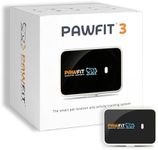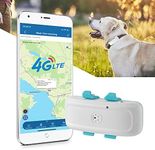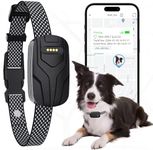Buying Guide for the Best Dog Trackers
Choosing the right dog tracker can be a bit overwhelming with the variety of options available. A dog tracker is a device that helps you keep tabs on your pet's location and activity, ensuring their safety and well-being. To make an informed decision, it's important to understand the key specifications and how they align with your needs and your dog's lifestyle. Here are the main specs to consider when picking a dog tracker.Tracking TechnologyTracking technology determines how the device locates your dog. Common technologies include GPS, Bluetooth, and radio frequency. GPS is the most accurate and works well for long distances, making it ideal for dogs that roam far. Bluetooth is suitable for short-range tracking, perfect for indoor use or small yards. Radio frequency is reliable for medium distances and doesn't rely on cellular networks. Choose based on where your dog spends most of their time and how far they tend to wander.
Battery LifeBattery life indicates how long the tracker can operate before needing a recharge. This is crucial for ensuring continuous tracking. Trackers with longer battery life are better for active dogs or those that spend a lot of time outdoors. Shorter battery life may be sufficient for less active dogs or if you can recharge the device frequently. Consider your dog's activity level and your ability to recharge the device when selecting battery life.
Durability and WaterproofingDurability and waterproofing determine how well the tracker can withstand rough play and various weather conditions. A durable, waterproof tracker is essential for active dogs that enjoy outdoor adventures, swimming, or playing in the rain. For more sedentary dogs or those that stay indoors, a less rugged device may suffice. Assess your dog's lifestyle and choose a tracker that can handle their level of activity and exposure to the elements.
Size and WeightSize and weight affect your dog's comfort while wearing the tracker. Smaller, lighter trackers are better for small breeds or puppies, ensuring they don't feel weighed down. Larger dogs can comfortably wear bigger, slightly heavier trackers. It's important to choose a tracker that your dog can wear comfortably without it being a nuisance or hindrance.
RangeRange refers to the maximum distance over which the tracker can effectively locate your dog. A longer range is beneficial for dogs that roam large areas, such as those in rural settings or on large properties. Shorter ranges are adequate for dogs that stay close to home or in smaller, confined areas. Consider where your dog typically spends their time and how far they might wander when selecting the range.
Subscription FeesSome dog trackers require a subscription fee for accessing tracking services, especially those using GPS and cellular networks. These fees can vary and are important to consider for long-term use. If you prefer not to have ongoing costs, look for trackers that offer free tracking services. Weigh the benefits of advanced tracking features against the cost of subscription fees to determine what works best for you.
Additional FeaturesAdditional features can enhance the functionality of the tracker. These may include activity monitoring, health tracking, geofencing, and alerts. Activity monitoring and health tracking are great for keeping tabs on your dog's fitness and well-being. Geofencing allows you to set safe zones and receive alerts if your dog leaves these areas. Choose features that align with your priorities and your dog's needs to get the most out of the tracker.












